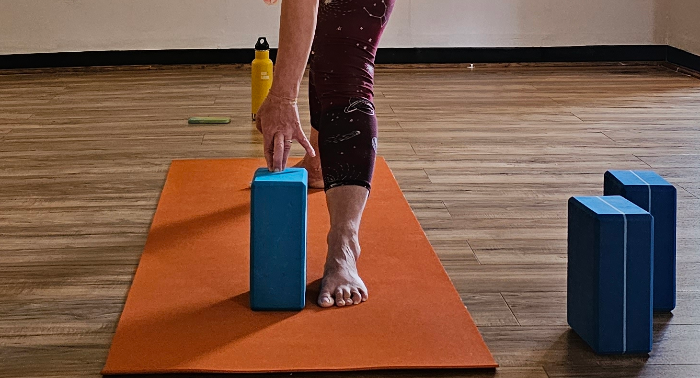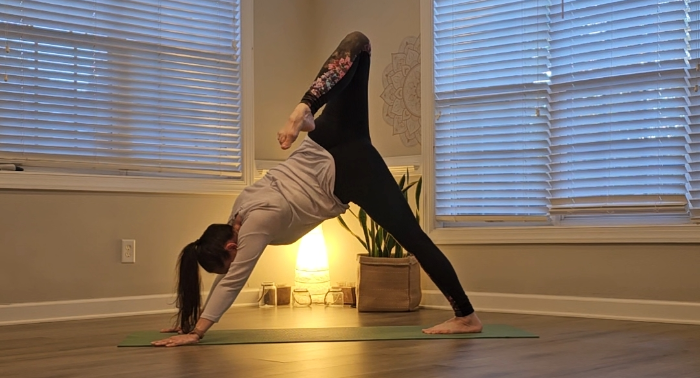Kicking Butt Through Menopause: Adjusting My Ashtanga Practice with Kindness

As a long-time Ashtanga yoga teacher, I’ve spent years with my body in a constant dance of strength, flexibility, and focus. The rigid structure of Ashtanga served as a solid foundation for both my personal practice and teaching, helping me feel grounded, strong, and capable. But recently, life’s natural rhythms have introduced me to a new phase that I didn’t expect to change my practice in quite the way it has. Menopause.
Let’s be honest—when I first started feeling the shifts in my body, I didn’t know what to make of it. I was used to pushing my limits, holding poses with endurance, and embracing the challenging side of Ashtanga. But now, my body is speaking a language that’s different from the one I’ve known for years. It’s been an adjustment. There have been aches, fatigue, and changes in strength that I wasn’t anticipating. But rather than fight it, I’ve chosen to listen. And in that listening, I’m not only finding a new kind of practice but also learning how to be kinder to myself in the process.
The First Signs: A Gentle Shift
It started subtly at first—slightly stiffer joints, more aches after class, and a general sense of fatigue that lingered longer than it used to. Where I once felt invincible, now there were days where I felt as though my body was holding me back. Poses that were once easy suddenly felt impossible. Flexibility that came effortlessly now required more time to ease into. The heat that used to fuel my practice seemed more intense, and there were moments when I felt a bit like I was on the outside looking in at the teacher I used to be.
But instead of getting frustrated, I decided to give myself permission to evolve alongside these changes. It became clear: my practice needed to shift to honor my body’s needs, not fight against them.
Embracing Adaptation: A New Kind of Strength
Menopause doesn’t just shift the body; it shifts the way we think about strength. It’s not about the same intensity or the same endurance I once relied on. Strength, in this new phase, is about adaptability and resilience. The power of my practice isn’t measured in how many vinyasas I can push through but in how well I honor my limits and find new ways to move with ease and grace.
I’ve learned to listen to my body more than ever before. When my body says “slow down,” I listen. When it says “rest,” I rest. I no longer push through the discomfort, thinking I’m “failing” at something. Instead, I meet myself where I am and practice with compassion.
Modifying the Sequence: Adjusting to Fit the Body
One of the first adjustments I made to my practice was modifying my Ashtanga sequence. The traditional series is built for a younger, more flexible body. While it’s still my foundation, I now approach it with more modifications.
Backbends: In the past, I would flow through deep backbends like Ustrasana and Dhanurasana with ease, but now I find myself being more cautious. I’ve added more warm-up poses for the spine, using blocks and bolsters for extra support in backbends. Instead of pushing for the deepest arch, I focus on lengthening the spine and gently opening the chest.
Standing Poses: These are the heart of the Ashtanga practice, but I’ve noticed that my hips and knees need more attention these days. I’ve incorporated longer holds in poses like Warrior II and Parsvakonasana to allow my muscles and joints to gradually open. It’s a more mindful approach, focusing on alignment and awareness rather than just getting the posture “right.”
Seated Postures: Forward folds and hip openers used to be my go-to for calming down after a long practice. Now, instead of pushing for a deep fold, I use props like straps and blankets to support my body in a more relaxed position. I’ve found that more time in Supta Baddha Konasana, for example, has helped open my hips and calm my nervous system without straining.
Restorative Poses: These have become a regular part of my routine. I give myself permission to slow down and embrace poses like Child’s Pose or Savasana without the rush to move on. Instead of finishing with the typical power finish, I sometimes end with longer periods of stillness or breathwork, tapping into the deep restorative benefits of yoga.
Kindness Over Perfection
One of the hardest lessons I’ve learned is to be kind to myself. Yoga has always been a way for me to strive for something more—more flexibility, more strength, more endurance. Now, it’s about letting go of the idea that I need to "perform" or "achieve" in the same way I did in the past.
I’m learning to be present with what I can do today, not what I did yesterday. It’s not about being perfect—it’s about being real. On the days when I don’t have the energy to move through the entire sequence, I allow myself the space to rest. On the days when my body feels like it’s ready to kick butt, I lean into that energy. And I’ve realized that in doing so, my practice is as potent as ever, just in a different way.
Still Kicking Butt
Even though I’m adapting my practice, I’m still kicking butt—just in a way that aligns with this new phase of life. Menopause has forced me to reframe my idea of strength, resilience, and endurance. I’m no longer pushing through pain or striving for perfection. Instead, I’m meeting myself where I am, and in doing so, I’m discovering a deeper kind of strength: the strength to be kind to myself, the strength to adjust, and the strength to evolve.
As a teacher, I’ve learned to model this kindness to my students. I show them that it’s okay to change, that our bodies are ever-evolving, and that yoga is a practice of acceptance and self-love. We are all going through transitions—whether it’s menopause, aging, or other life changes—and yoga is there to help us navigate those transitions with grace.
I might not be performing the way I once did, but I’m still showing up, still breathing, and still honoring my body. And in that, I’m kicking butt.




